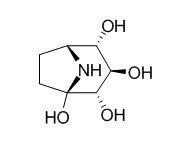Calystegine B2
Calystegine B2 can inhibit the alpha-galactosidase and enzymes beta-glucosidase activities.
Inquire / Order:
manager@chemfaces.com
Technical Inquiries:
service@chemfaces.com
Tel:
+86-27-84237783
Fax:
+86-27-84254680
Address:
1 Building, No. 83, CheCheng Rd., Wuhan Economic and Technological Development Zone, Wuhan, Hubei 430056, PRC
Providing storage is as stated on the product vial and the vial is kept tightly sealed, the product can be stored for up to
24 months(2-8C).
Wherever possible, you should prepare and use solutions on the same day. However, if you need to make up stock solutions in advance, we recommend that you store the solution as aliquots in tightly sealed vials at -20C. Generally, these will be useable for up to two weeks. Before use, and prior to opening the vial we recommend that you allow your product to equilibrate to room temperature for at least 1 hour.
Need more advice on solubility, usage and handling? Please email to: service@chemfaces.com
The packaging of the product may have turned upside down during transportation, resulting in the natural compounds adhering to the neck or cap of the vial. take the vial out of its packaging and gently shake to let the compounds fall to the bottom of the vial. for liquid products, centrifuge at 200-500 RPM to gather the liquid at the bottom of the vial. try to avoid loss or contamination during handling.
Applied Biological Chemistry 2022, 65,5(2022).
Food Chem.2022, 378:131975.
Biomed Chromatogr.2022, 36(11):e5462.
Int J Biol Macromol.2025, 292:139225.
Food Analytical Methods2020, 1-10
Oxid Med Cell Longev.2022, 2022:9139338.
Enzyme Microb Technol.2022, 161:110111.
Molecules.2018, 23(9):E2121
Chinese Journal of Hospital Pharmacy2020, 40(7)
Nat Prod Sci.2019, 25(3):238
Related and Featured Products
J Nat Prod. 1996 Dec;59(12):1137-42.
Biological activities of the nortropane alkaloid, calystegine B2, and analogs: structure-function relationships.[Pubmed:
8988598 ]
METHODS AND RESULTS:
Calystegines, polyhydroxy nortropane alkaloids, are a recently discovered group of plant secondary metabolites believed to influence rhizosphere ecology as nutritional sources for soil microorganisms and as glycosidase inhibitors.
Evidence is presented that calystegines mediate nutritional relationships under natural conditions and that their biological activities are closely correlated with their chemical structures and stereochemistry. Assays using synthetic (+)- and (-)-enantiomers of Calystegine B2 established that catabolism by Rhizobium meliloti, glycosidase inhibition, and allelopathic activities were uniquely associated with the natural, (+)-enantiomer. Furthermore, the N-methyl derivative of Calystegine B2 was not catabolized by R. meliloti, and it inhibited alpha-galactosidase, but not beta-glucosidase, whereas the parent alkaloid inhibits both enzymes.
CONCLUSIONS:
This N-methyl analog therefore could serve to construct a cellular or animal model for Fabry's disease, which is caused by a lack of alpha-galactosidase activity.
J Nat Prod. 1995 Jun;58(6):878-86.
Identification of the glycosidase inhibitors swainsonine and calystegine B2 in Weir vine (Ipomoea sp. Q6 [aff. calobra]) and correlation with toxicity.[Pubmed:
7673932]
METHODS AND RESULTS:
The polyhydroxy alkaloid glycosidase inhibitors swainsonine [1] and Calystegine B2 [6] have been identified as constituents of the seeds of the Australian plant Ipomoea sp. Q6 [aff. calobra] (Weir vine) by gas chromatography-mass spectrometry and by their biological activity as inhibitors of specific glycosidases. This plant, which is known only from a small area of southern Queensland, has been reported to produce a neurological disorder when consumed by livestock. The extract of the seeds showed inhibition of alpha-mannosidase, beta-glucosidase, and alpha-galactosidase, consistent with the presence of 1 and alkaloids of the calystegine class. Histological examination of brain tissue from field cases of sheep and cattle poisoned by Weir vine showed lesions similar to those observed in animals poisoned by the swainsonine-containing poison peas (Swainsona spp.) of Australia and locoweeds (Astragalus and Oxytropis spp.) of North America.
CONCLUSIONS:
These results indicate that Weir vine poisoning is an additional manifestation of the induced lysosomal storage disease, mannosidosis, possibly exacerbated by inhibition of the enzymes beta-glucosidase and alpha-galactosidase by Calystegine B2.
This is the first reported example of a single plant species capable of producing structurally distinct glycosidase inhibitors, namely, alkaloids of the indolizidine and nortropane classes.
J Org Chem. 2012 Jan 20;77(2):991-8.
Executing and rationalizing the synthesis of a difluorinated analogue of a ring-expanded calystegine B2.[Pubmed:
22148579 ]
METHODS AND RESULTS:
A difluorinated analogue of a ring-expanded calystegine B(2) and some N-protected species were prepared via microwave-mediated transannular ring-opening of an epoxyketone.
CONCLUSIONS:
The diastereofacial selectivity of the epoxidation reaction, which delivers the key intermediate, and the regioselectivity of the transannular reactions were analyzed by density functional theory (DFT) methods. The epoxidation stereoselectivity arises from simple steric control, whereas the ring-closure reactions are subject to thermodynamic control.
J Org Chem. 2001 Nov 16;66(23):7604-14.
Synthesis and evaluation of calystegine B2 analogues as glycosidase inhibitors.[Pubmed:
11701011]
A practical synthesis of polyhydroxylated 6-oxa-nor-tropanes incorporating the essential structural features of calystegine B(2) from 5-deoxy-5-thioureido and 5-ureido-L-idofuranose precursors is presented.
METHODS AND RESULTS:
The methodology relies on the ability of pseudoamide-type nitrogen atoms (thiourea, urea, and carbamate) to undergo nucleophilic addition to the masked aldehyde group of the monosaccharide. The generated hemiaminal functionality may further undergo in situ intramolecular glycosidation to give the bicyclic aminoacetal compounds, the whole process being favored by the anomeric effect.
CONCLUSIONS:
A series of derivatives bearing different substituents at nitrogen has been prepared and screened against several glycosidases in comparison with xylonojirimycin-type piperidine analogues.
Interestingly, strong and highly specific inhibition of bovine liver beta-glucosidase was observed for 6-oxacalystegine B(2) analogues incorporating aromatic pseudoaglyconic groups. On the basis of these data, a 1-azasugar inhibition mode is proposed for this family of glycomimetics.



